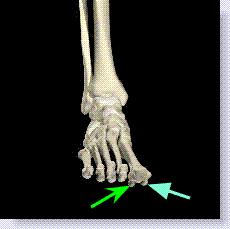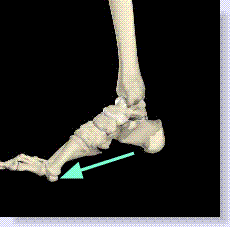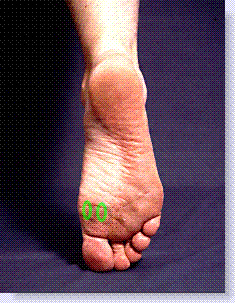sesamoiditis
AUTHOR: Marc Mitnick DPM home --> sesamoiditisWHAT IS SESAMOIDITIS
Sesamoiditis of the foot is a fairly common condition that causes forefoot pain. Located on the ball of the foot behind the big toe joint are two small “jelly bean” size bones. These bones are located under the head of the first metatarsal bone.
Below is a skeletal model showing the location of the sesamoid bones. The first view is of the foot coming towards you. The green arrow is pointing towards the lateral sesamoid, also known as the fibular sesamoid, while the blue arrow is pointing towards the medial sesamoid, known as the tibial sesamoid. The second view is a side view. See how the sesamoid bones are directly underneath the first metatarsal bone. Also note that the higher the arch of a foot, the more pressure there is on the sesamoid bones.

|

|
Their purpose is to act as a lever or fulcrum for the flexor tendons, the tendons which allow the big toe to bend down. There are generally two sesamoid bones but sometimes one bone will actually be two smaller bones and you have a condition known as bipartate sesamoid bones.
The problem with these bones is their location. As you can see from the picture, they are located directly underneath a major weight bearing area of the foot.

|
SYMPTOMS OF SESAMOIDITIS
Because of this they are prone to pressure and trauma. Factors such as the size of the sesamoid bones, the weight of the patient, the particular foot structure of the patient, activity of the patient and the types of shoe the patient is wearing can all contribute to the inflammation of the sesamoid bones and the ligaments that attach them to the larger first metatarsal bone.
Typically sesamoiditis symptoms range from a dull ache to a sharp pain every time the patient walks. The affected area may be swollen and slightly red. Bending the big toe upwards will generally cause the pain to worsen. The onset of symptoms of sesamoiditis can be gradual over a period of time with eventually the pain becoming so bad the patient has to seek treatment. Conversely, a day of walking in a very dressy shoe on the streets of Manhattan, for example, can set off the pain so that by the next day the patient is in a great deal of pain.
The area will be more painful barefoot on a hardwood or tiled floor and will feel a little bit better walking on carpeting or in a padded shoe such as a sneaker. People who wear very thin soled shoes and women who wear high heels will experience more pain because the thin sole does not protect the area and the lift of the foot from the high heel puts more pressure directly on the sesamoid bones.
When there has been a large amount of stress to the sesamoid bone there is also the possibility of fracturing the bone. At times it can be very difficult to make a diagnosis of a fractured sesamoid by x-ray alone and frequently either a bone scan or MRI will be ordered to confirm the diagnosis.
TREATMENT FOR SESAMOIDITIS
conservative care of sesamoiditis
Because of their location, injuries to the sesamoid bones can be very difficult to treat.
Treatment in minor cases include:
- anti-inflammatory medication can be very helpful, given in a regimented dosage over 10-14 days.
- strapping of the big toe joint to limit its movement upward.
- A cushioned innersole has to be added to the shoe to protect the sesamoid bone from ground pressure.
- wearing a good solid laced shoe with a low heel and not flimsy dress shoes during the healing process. Shoes for sesamoiditis should also include a rigid sole which helps prevent the big toe from bending upwards, as well as a cushioned sole.
- In more severe cases a cortisone injection may be helpful for sesamoiditis but not for sesamoid fracture.
- Application of an off loading cast or use of crutches in an effort to keep pressure off the sesamoids in instances where other treatments have failed.
- Physical therapy for sesamoiditis can be very helpful as an adjunct treatment.
In the case of a fractured sesamoid at the minimum the patient needs to be in a cast.
sesamoid surgery and potential complications
There are some situations that just do not seem to respond to the preceding therapies. At times the offending sesamoid can be removed surgically, however, that creates a multitude of potential problems. Since the bones are embedded in the tendons that help the big toe move, removing a sesamoid bone can adversely affect the function of the tendon and can cause the big toe to move either toward the second toe or away from the second toe thus creating instability in the great toe joint.
If the problem with the offending sesamoid is that it is too large or a bipartate sesamoid (double bone), particularly the sesamoid on the inside of the foot (medial), it can be shaved down without totally removing it.
CHRONIC SESAMOIDITIS
People who are prone to this type of condition have to be sensible in their approach to shoe selection and activities. If you are going to insist on wearing shoes that exacerbate the problem, all the therapy in the world will not remedy the problem.
The same is true for those who may participate in an activity that forces the foot to excessively bend at the big toe joint. (stooping down while gardening for example) Those people must wear shoes that will cushion and protect that part of the ball of the foot. Many times I will prescribe an orthotic to counter the forces that are causing the pain. Orthotics for sesamoiditis will often include what is known as a dancer's pad which is a cushion that is built into the orthotic around the affected sesamoid in an effort to keep the sesamoid from hitting the ground.
REFERENCES
Loyola University Medical Center
see related article....sesamoid fractures
see related article....orthotics
Want more information? CLICK HERE


Recent Articles
-
Vitamin D impact on health
Feb 06, 23 07:17 PM
Researchers are suggesting that the effectiveness of Vitamin D in fighting and preventing disease is predicated on a persons body mass index (BMI). The thinner the person the greater the positive impa… -
Foods to speed up healing
Feb 01, 23 02:41 PM
One of the best ways to help yourself heal faster after surgery is to eat well. Getting the proper nutrition will provide your body with the essentials it needs to promote healing. Here is a suggestio… -
Cancer and Type 2 Diabetes
Jan 25, 23 04:52 PM
An article revealing that older type 2 diabetics have a higher incidence of cancer then non-diabetics. It is suggested that cancer may surpass CVD as the number one cause of death in older diabetics. -
Does glucosamine or MSM reduce arthritis pain?
Jan 22, 23 01:41 PM
A good review of the possible benefits to taking glucosamine, chondroitin or MSM for arthritis. Always beware of the possible side effects of over the counter supplements. -
shin splints
Jan 18, 23 05:12 PM
A great review on the various causes of shin splints, along with treatment options. -
Whats new in skin cancer?
Jan 15, 23 08:32 PM
A presentation of newer skin protection combinations in an effort to better protect the skin from the hazards of sun exposure. -
Causes and risk factors of warts
Jan 14, 23 05:02 PM
A good review of the causes of warts and protective measures you can take to prevent developing them. -
Do chronic wounds need to be dressed daily?
Jan 11, 23 02:18 PM
Because of supply chain shortages as well as staffing shortages particularly during the pandemic, many institutions extended the time between dressing changes for chronic wounds. Is this really the be… -
Food choices that raise your risk of type 2 diabetes
Jan 08, 23 10:07 AM
A good review of how blood sugars can become elevated and the harm that can do. Certain food groups have a tendency to raise your blood sugars and should be avoided. -
Outcome stats from Scarf bunionectomy
Jan 03, 23 03:04 PM
The Journal of Foot and Ankle Surgery recently reported a meta analysis of outcomes in 1583 Scarf bunionectomies that met their inclusion criteria. Adverse events did not seem to be any better or wors…